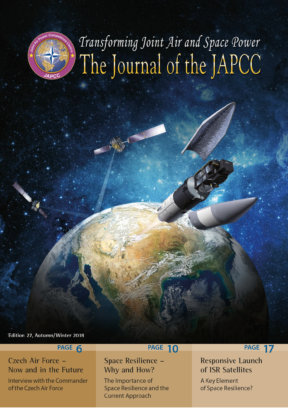Introduction
The projection of Air Power today is clearly focused on the operation and advancement of 5th generation fighter aircraft, such as the F-35 Lightning II Joint Strike Fighter, and on the continuous development of Unmanned Combat Aircraft Systems (UCAS), such as the Predator C Avenger.
It might appear that the complete coverage of Air Power is guaranteed. However, the operation of the best and most powerful fighter aircraft, in combination with more and more autonomous working UCAS, comes with a huge price tag. This price tag includes not only the enormous expenses of buying, maintaining and operating the sophisticated weapon systems, but also the development cost of each system, and that spending seems to increase exponentially with every new technological generation. In addition, the expenses and time to train combat-ready aircrews and qualified mechanics add up quickly.
Immense expenses combined with limited availability might make the priority for 5th generation fighter aircraft employment the countering of adversary high-end capabilities. The numbers illustrate that the new generation of fighter aircraft might become too valuable a resource to be risked on missions supporting ground forces in semi-permissive or low-threat environments. Nowadays, legacy fighters, such as F-16s, F-15s, and F/A-18s, as well as Eurofighters, Rafales and Tornados are delivering a massive impact during missions abroad. For many smaller operations, the employment of UCAS might seem to be a suitable solution. However, legacy fighters will sooner or later be replaced by 5th generation fighters and the UCAS currently lack the necessary flexibility in terms of weapon load-out and mission reallocation while in the air, to support different types of mission.
It seems that, in spite of the great potential these weapon systems offer, there is an existing void between mission value and suitable equipment which could be filled with a less expensive yet adequate weapon system.
The OA-X Programme
This might be the idea behind the Light-Attack Aircraft programme (OA-X) of the United States Air Force (USAF). The programme was formally started by the USAF with a Request for Information (RFI) in 2009.1 The focus on a possible Light-Attack Aircraft (LAA), to enter service in 2013, derived from the lessons learned from multiple operations during low-intensity conflicts in Iraq and Afghanistan. The outcome was the purchase of twenty A-29 Super Tucano aircraft for the Afghan Air Force. The re-start of the OA-X programme in 2017 highlights the importance of the requirement for a LAA. Considering the capabilities, cost and availability of fighter-bomber aircraft and UCASs of the present and the future, it may therefore be the case that there is a niche for LAA for the foreseeable future.
Advantages of Light-Attack Aircraft
There are numerous challenges during the development and introduction of any new weapon system, and therein one of the LAAs biggest advantages. An off-the-shelf aircraft can be transformed into a LAA, which offers various options and possibilities to conserve resources concerning aircraft development, aircrew and technician training, and sophisticated equipment. Examples include the Air Tractor AT-802L Longsword, a modified variant of the Air Tractor AT-802, an agricultural and fire-fighting aircraft, and the AT-6 Wolverine, a light attack variant of the trainer aircraft T-6 Texan II, which is currently the primary basic trainer of the USAF, the United States Navy (USN) and Hellenic Air Force. Additionally there are existing LAA, such as the A-29 Super Tucano, also known as EMB 314 Super Tucano. The two-seat, single turboprop-powered aircraft includes state-of-the-art radios, data link and multiple sensors (electro-optical, infrared and Laser designation/illumination/range-finding). The military aviation equipment on board was originally developed for modern fighter aircraft, including the 5th generation fighter, and has been successfully integrated into the airframes. The aircraft’s cockpit and engine are armour-protected. Multiple weapon stations, including a wide spectrum of weapons and ammunition, as well as a capable self-defence system complete the LAA. The unit cost is expected to be approximately USD 12 million to USD 13 million, with operating costs of USD 1,200 to USD 1,600 per flight hour.2 Compared to the legacy fighters and 5th generation fighters, and even the A-10 Thunderbolt II, these operational costs are significantly less. By reducing the number of missions which have to be flown by expensive jet fighter aircraft, including a noticeable contingent of the A-10, the purchase of LAA would not only pay dividends by prolonging the lifetime of the jet aircraft, but also by saving resources during actual operations.
In addition to the actual costs of buying and operating a new aircraft, there are more features to be considered. Clearly a LAA, just like any legacy fighter, will not be able to substitute for a 5th generation fighter, which is able to penetrate hostile airspace with a significantly reduced chance of detection, due to its cutting-edge stealth technology. However, it seems that the LAA could play a major role in Small Joint Operations (SJO), where the need for stealth technology and superior fighters might not be a top priority, but supporting the troops on the ground is. And this is exactly what the LAA was ‘purpose-built’ for. It can employ precision-guided munitions (GBU-12, GBU-59, GBU-48 and GBU-58) as well as general-purpose bombs (Mk-81 and Mk-82). In addition, it can be equipped with laser-guided rockets and missiles and, most importantly, .50 calibre guns. For defensive air-to-air, anti-helicopter and/or anti-UCAS purposes, AIM-9M/X Sidewinder missiles could be fitted. The flight time, depending on the configuration, ranges between three and five hours. The modern cockpit is a digital glass cockpit including Head-Up-Display (HUD), Hands-On-Throttle-And-Stick (HOTAS) and weapons management system. The secure UHF and VHF radios, as well as the data link via link-16, ensure successful integration and interoperability into the modern warfare environment.
Successful integration and interoperability is definitely a priority for any new weapon system that is being introduced in any military domain. NATO defines interoperability as ‘the ability to act together coherently, effectively and efficiently to achieve Allied tactical, operational and strategic objectives’.3 Interoperability ‘allows forces, units or systems to operate together. It requires them to share common doctrine and procedures, each other’s infrastructure and bases, and to be able to communicate with each other’.4Successful integration into the modern warfare environment can only be achieved via a multi-domain approach, to cover all mission-critical areas during the full spectrum operations.
Areas of Operation
The well-equipped LAA might be a valuable complementary capability with unexpected synergies in future multi-domain operations. These include Close Air Support (CAS), Intelligence, Surveillance and Reconnaissance (ISR) missions, Counter-Insurgency (COIN), armed over-watch and, due to the excellent communications and sensor equipment, Forward Air Controller (Airborne) (FAC[A])missions. Based on these capabilities, the LAA could even exert allocated Command and Control (C2) of the ground battle in an assigned area. To achieve this, the ground commander or a liaison officer could utilize the rear seat in a LAA. For such a scenario it should be clarified that LAAs would have to operate at least in a formation of two aircraft for mutual support and to accomplish the high task load. Because of the wide range of missions in multi-domain operations, the integration of LAA even into a Major Joint Operation (MJO) can be a valuable addition and critical resource. The LAA could provide the ‘eyes and weapons’ in the sky for the ground troops. This direct support would not just be a kinetic strike capability and airborne protection against opposing forces on the ground, but also a moral boost for own troops.
To improve the support efficiency of the ground troops by LAA, different load-out options within a formation could be considered. For example, one option could be a ground-attack variant, characterized by a heavy weapon load-out, maximizing the kinetic strike potential. Another option could be a self-defence load-out, to defend primarily against opposing UCAS, helicopters and attacking aircraft. Excellent support and security, especially for the ground troops, could be provided by a sensor and jamming load-out, to identify possible Improvised Explosive Devices (IEDs) or interrupt the opponents’ lines of communication.
Drawbacks and Challenges
A huge drawback compared to the jet aircraft is the distinctively slower response time, due to the significant difference in speed. This impact can be reduced by the use of Forward Operating Bases (FOBs), but it cannot be eliminated. Airfield requirements for LAA are less demanding compared to any jet aircraft. The required runway length and consistency (grass or gravel), in combination with easier maintainability of the aircraft and minimal logistic effort, could turn even a small airstrip into a high-value FOB. This would offer completely new levels of integration for fixed-wing aircraft into the support of ground troops. Aircrews would have the valuable opportunity to plan and brief future operations face-to-face with the troops on the ground. The ground commander could be integrated in an airborne C2 function as mentioned above. In addition, the coordination with helicopter aircrews, who are using FOBs more regularly, could be instantly improved to ensure the joint cooperation. Regular transport missions, MEDical EVACuation (MEDEVAC) missions or Personnel Recovery (PR) missions could be planned more precisely and therefore executed more efficiently. The benefits of this level of integration could be vital for the overall success of any future operation.
Building Partner Capacity
Another rarely recognized and widely underestimated advantage which the LAA offers, is in Building Partner Capacity (BPC).5 Providing resources for developing nations, and assisting their training to evolve their own Air Power capability, is an important soft power tool, especially in irregular conflicts like Afghanistan and Iraq. The combination of an affordable aircraft, reasonable priced training for aircrews, straightforward maintenance and logistic requirements make it a great platform for economically unstable states. The long-term goal would be to deploy LAA for Irregular Warfare (IW) operations in the aforementioned states by their own aircrews, without direct support of Alliance aircraft.
Conclusion
The existing assets of 5th generation fighters, legacy fighters and UCASs are sufficient and adequately equipped to operate in the joint arena of battlespaces around the globe. However, there is a huge price tag attached to their capabilities, which quite often exceeds the perceived value of ‘low-end’ ground attack and support missions.
Comparing the cost and effort to operate LAA in a permissive low-threat environment, such as Afghanistan or Iraq, with the 5th generation fighter and even the legacy fighters, including the A-10 Thunderbolt II, shows that this alternative could pay off quickly. Not only in monetary terms, but also with efficiencies in personnel and equipment. The LAA will not be a substitute for 5th or even 4th generation aircraft, but could be an expedient and economical short-to-mid-term solution to support the right kinds of operations for a prolonged time frame.
The LAA concept offers great value for money. There are several fully developed, battle-tested and readily available airframes already serving as LAA. They support a variety of missions in operating areas which cannot be met by many other aircraft. This puts them in a top spot of the most efficient aircraft, tactically and economically. To benefit from the positive side effects ascribed to the fleet of legacy and 5th generation fighters, an expeditious procurement of LAA seems to be a solid solution. It would be an investment into saving on the defence budget of any military armed force. The aforementioned OA-X programme in the US characterizes the urgency of the matter. The programme is down to two aircraft, the A-29 Super Tucano and AT-6 Wolverine. More testing was done during the second phase of OA-X experimentation, from May to July 2018, to expedite the procurement process and purchase the first aircraft in 2019. The LAA is a cost-effective solution for an enduring niche need, and it seems to be a wise approach to explore this capability as a way to get more combat capability out of limited budgets.












